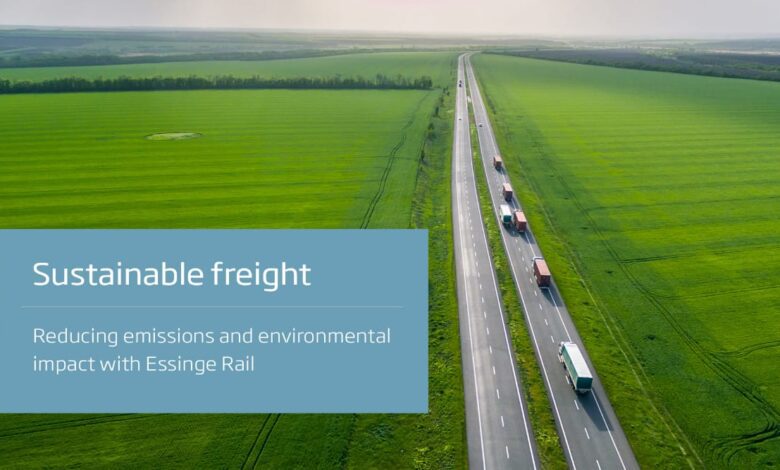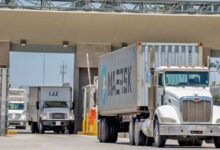Sustainable Freight Transportation: Reducing Emissions and Environmental Impact with Essinge Rail

In today’s world, sustainability has become a crucial factor in the field of freight transportation. With a focus on minimizing emissions and environmental impact, the industry is actively adopting strategies to promote greener practices. We aim to provide valuable insights and perspectives for individuals or businesses considering a switch in their transportation methods. We will explore various advantages, disadvantages, and solutions in the context of sustainable freight transportation.
The Function of Freight Transportation
Freight transportation plays a vital role in connecting supply chains and facilitating the movement of goods across different sectors. Industries such as manufacturing, retail, and agriculture heavily rely on efficient and reliable transportation to ensure the smooth flow of products from origin to destination. However, the conventional modes of transportation, predominantly fueled by non-renewable resources, have posed significant challenges in terms of environmental sustainability.
The Need for Sustainable Transportation Solutions
To address the environmental concerns associated with freight transportation, innovative approaches are being employed. By embracing sustainability practices, we can mitigate carbon dioxide emissions and promote a greener future. Let’s explore some of the strategies being implemented to achieve this goal:
1. Electrification of Vehicles
One promising avenue for reducing emissions in freight transportation is the adoption of electric vehicles (EVs). EVs offer a cleaner alternative to traditional diesel-powered trucks and vans. With advancements in battery technology, EVs have become increasingly capable of handling long-haul journeys while minimizing environmental impact. The integration of charging infrastructure is crucial to support the widespread use of electric vehicles.
2. Utilization of Renewable Fuels
Another sustainable solution is the utilization of renewable fuels such as biogas and biodiesel. These fuels are derived from organic sources and have lower carbon footprints compared to conventional petroleum-based fuels. By transitioning to renewable fuels, the freight transportation industry can significantly reduce greenhouse gas emissions and contribute to a cleaner environment.
3. Efficient Logistics and Route Optimization
Optimizing logistics and routes is an essential aspect of sustainable cargo freight transportation. By implementing advanced technologies and data-driven strategies, companies can streamline their operations, reduce fuel consumption, and minimize unnecessary mileage. Route optimization not only reduces emissions but also enhances overall efficiency, leading to cost savings for businesses.
Realizing the Benefits: Green and Sustainable Freight Transportation
Now, let’s delve into the benefits that can be realized through the adoption of green and sustainable practices in freight transportation:
- Environmental Impact Reduction: By embracing sustainability, the industry can make significant strides in reducing carbon dioxide emissions and minimizing the overall environmental footprint. This positive impact contributes to preserving the planet for future generations.
- Cost Savings: While transitioning to greener practices may require initial investments, the long-term benefits can outweigh the costs. Energy-efficient vehicles, optimized logistics, and reduced fuel consumption lead to substantial cost savings in the form of lower operational expenses.
- Enhanced Reputation: Companies that prioritize sustainability and actively engage in green initiatives tend to foster a positive brand image. By showcasing their commitment to environmental responsibility, they can attract environmentally conscious customers and gain a competitive edge in the market.
- Compliance with Regulations: Governments worldwide are introducing stringent regulations to curb emissions and promote sustainability. By adopting green freight transportation practices, businesses can ensure compliance with evolving environmental standards, avoiding potential penalties or restrictions.
Challenging Perspectives and Open Questions
While the benefits of green and sustainable freight transportation are evident, it is crucial to acknowledge and address the challenges and open questions associated with this transition:
- Infrastructure Requirements: The widespread adoption of electric vehicles and alternative fuels necessitates the development of robust charging and refueling infrastructure. Governments and private entities must collaborate to build a reliable network to support these sustainable technologies effectively.
- Economic Viability: Despite the long-term cost savings, the initial investment required to implement sustainable freight transportation practices can be a deterrent for some businesses. Finding a balance between the economic viability and environmental benefits is a key consideration for organizations.
- Technology Advancements: While electric vehicles and renewable fuels have shown promise, ongoing advancements in technology are necessary to improve their efficiency, range, and charging capabilities. Continued research and development in this field will further drive the adoption of sustainable transportation solutions.
- Supply Chain Integration: Shifting towards green freight transportation involves collaboration and coordination among multiple stakeholders within the supply chain. Efficient integration of sustainable practices across all stages, from production to delivery, is essential for maximum impact.
As we consider the challenges, it’s important to view them as opportunities for growth and innovation. By addressing these concerns, we can accelerate the transition to greener and more sustainable freight transportation.
The Case of Essinge Rail: A Leading Example
Essinge Rail AB is a prime example of a company that exemplifies the principles of sustainable freight transportation. Their commitment to reducing emissions and promoting environmental responsibility sets them apart in the industry. Through the implementation of cutting-edge technologies, such as electric trucks powered by renewable energy sources, Essinge Rail AB has significantly reduced their carbon footprint.
Since 2006, Essinge Rail AB has established itself in the Nordic transport market. They specialize in international transportation and logistics operations from Europe, utilizing the conventional railway system primarily serving the forestry industry. Within their own operations, they transport 250,000 tons of goods annually, focusing on the food, retail, and manufacturing sectors.
To meet stringent standards of quality, safety, and environmental responsibility, Essinge Rail AB owns and operates their railway terminal and trucking fleet. Their entire process is digitalized, ensuring efficient operations and streamlined logistics. Their ultimate goal is to establish a completely seamless, fossil-free transportation chain, starting from the departure of the train on the continent and extending to the final delivery. This includes both shunting operations and terminal handling, powered by their self-generated solar energy, as well as distribution using modern trucks fueled by renewable alternatives such as HVO 100 or electricity.
Within the framework of the Science Based Targets initiative (SBTi), Essinge Rail AB has committed to aligning with the goals set forth in the Paris Agreement, specifically targeting a 1.5-degree Celsius global temperature increase limit. They closely monitor technological advancements and eagerly anticipate contributing to the increased electrification of the transportation sector.
Closing Thoughts
In conclusion, green and sustainable freight transportation is a critical component in addressing the environmental challenges posed by traditional transportation methods. Through strategies such as electrification, utilization of renewable fuels, and efficient logistics, the industry can significantly reduce carbon dioxide emissions and promote a greener future. While challenges exist, embracing sustainable practices presents opportunities for cost savings, enhanced reputation, and compliance with evolving environmental regulations.
As we move forward, it is crucial for businesses and individuals to consider the long-term benefits of sustainable transportation and make informed decisions that prioritize both environmental and economic well-being. By working together, we can create a greener and more sustainable future for the freight transportation industry.






